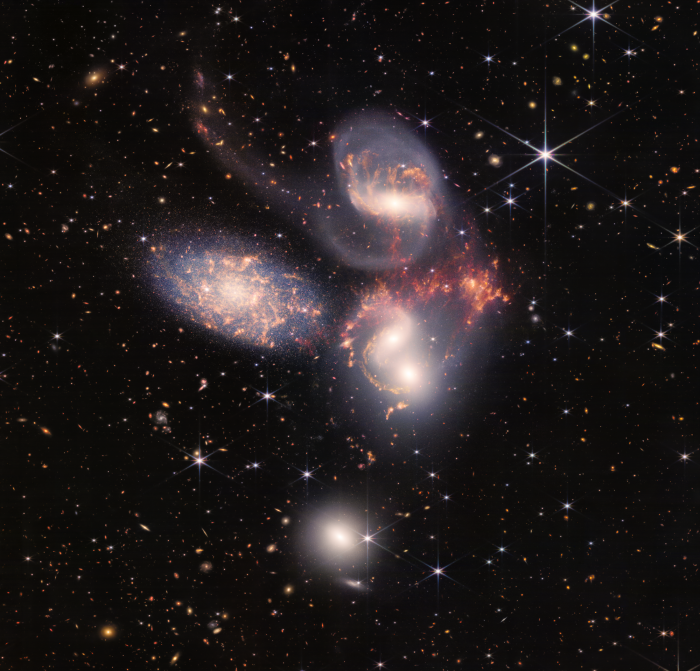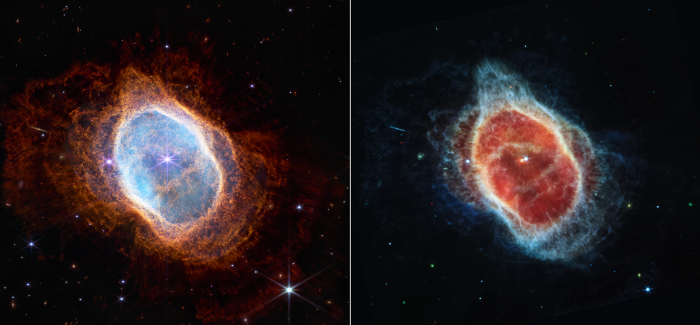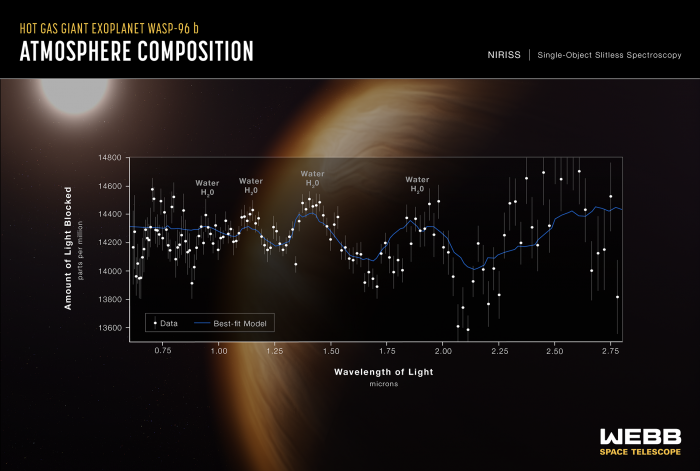Well, it worked!
The dazzling image of the star-forming Carina Nebula above, released hours ago, is just one indication that the James Webb Space Telescope (JWST) is doing what it was sent up to do—taking spectacular images of the cosmos.
Comparing this view with an image of the same nebula taken by the Hubble Space Telescope in 2007 reveals just how much more powerful JWST will prove to be. Exceptional details that previously eluded Hubble were captured in infrared light, tearing away the veil from intriguing pockets of the sky where dust is coalescing into stars and planets.
Imaged by JWST’s Near-Infrared Camera (NIRCam) and Mid-Infrared Instrument (MIRI), the landscape of mountains and valleys, called the Cosmic Cliffs, showcases the telescope’s capabilities to peer through cosmic dust, shedding new light on the process of how stars are born and its impact on the evolution of gigantic clouds of gas and dust. With Webb, scientists may be able to address some burning questions of modern astrophysics: What determines the number of stars that form in a certain region? Why do stars form with a certain mass?

Light from the faintest features in this image departed more than 13 billion years ago. Image credit: NASA, ESA, CSA, and STScl
JWST’s First Deep Field, an image of galaxy cluster SMACS 0723 as shown above, was revealed on Monday.
It’s the deepest and sharpest infrared image of the distant universe so far—teeming with THOUSANDS of galaxies. The image is approximately the size of a grain of sand held at arm’s length, a mere sliver of the vast, vast universe. Taken by NIRCam, this deep field is a composite made from images at different wavelengths, totalling 12.5 hours.
Light from these galaxies took billions of years to reach our eyes. So we’re looking back in time to within a billion years after the Big Bang when viewing the youngest galaxies in this field. Researchers will soon be able to dive deeper into the galaxies’ masses, ages, histories, and composition. Wonder why the field has features of prominent arcs and bends? The powerful gravitational field of a galaxy cluster can bend the light rays from more distant galaxies behind it—like how a magnifying glass bends and warps images.

One member of the “Stephan’s Quintet” of galaxies is much closer than the other four, which over time continue to swirl around and whip past one another. Two at the bottom have begun to merge. Image credit: NASA, ESA, CSA, and STScl
The above image is JWST’s largest image to date, covering about one-fifth of the Moon’s diameter. The enormous mosaic contains over 150 million pixels and is constructed from almost 1,000 separate image files.
Known as Stephan’s Quintet, the visual grouping of five galaxies provides researchers with a great “laboratory” for studying the processes of galaxy interactions and mergers, which are fundamental to all galaxies. The topmost galaxy (NGC 7319) harbours an active galactic nucleus—a supermassive black hole 24 million times the mass of the Sun. JWST’s NIRSpec and MIRI can study the nucleus in great detail, providing researchers with “data cubes”, or a collection of images of the galactic core’s spectral features. This allows them to “slice and dice” the info into many images for thorough study, uncovering a level of detail never seen before.

Near-infrared (left) and mid-infrared (right) images of the Southern Ring Nebula show shells of the material released by a dying pair of stars at the nebula’s centre; the outer orange layers (left image) are newly formed hydrogen and the blue is hot, ionised gas heated by the core. Image credit: NASA, ESA, CSA, and STScl
Ever witnessed a star’s last dance?
Now you’ve seen it in the image above!
Previously hidden from astronomers, the Southern Ring planetary nebula (NGC 3132) shows shells of gas and dust ejected from dying stars, brought into full view with JWST’s powerful infrared cameras.
The image shows a pair of stars, locked in a tight orbit, shaping the local landscape. On the left is the image taken by NIRCam, showcasing the stars and their layers of light. On the right is the image taken by MIRI, revealing for the first time that the second star is surrounded by dust. The dimmer star has been ejecting rings of gas and dust for thousands of years, while the brighter star is in an earlier stage of its stellar evolution, which will probably shoot out its own nebula in the future.
Each shell represents an episode where the dimmer star lost some of its mass—tracing these ejections allows astronomers to peer into the history of the system. New details like these, from the late stages of a star’s life, will help us better understand how stars evolve and transform their environments.

Spectrum from the NIRSpec instrument represents stunning evidence of clouds on an exoplanet, WASP-96b. The undulations in the amount of sunlight passing through the planet’s atmosphere correspond to water vapour. Image credit: NASA, ESA, CSA, and STScl
Zooming in to a hot, puffy gas giant called WASP-96b 1,150 light-years away, JWST has captured the distinct signature of water in its atmosphere, along with evidence of clouds and haze.
The spectrum of light shown above contains detailed information about the make-up of WASP-96b’s planetary atmosphere, measured by the telescope’s Near-Infrared Imager and Slitless Spectrograph (NIRISS). This spectrum is not only the most detailed near-infrared transmission spectrum of an exoplanet atmosphere captured to date, but it also covers a wide range of wavelengths from visible red light to wavelengths previously not accessible from other telescopes. The latter gives researchers more insight into the presence of water as well as other key molecules such as oxygen, methane, and carbon dioxide.
With a wealth of data that can now be captured, JWST will take exoplanet research to the next level. For instance, with the spectral data above, researchers can measure the amount of water vapour in the atmosphere, estimate the abundance of elements such as carbon and oxygen, and predict the temperature of the atmosphere with depth. Following that, inferences about the overall make-up of the exoplanet can be made, along with how, when, and where it formed.
As the release of this week’s first images marks the conclusion of JWST’s commissioning, we can expect more exciting and intriguing science soon as eager astronomers get allocated time on the telescope.
The telescope’s launch was much more accurate than estimated, which ultimately led to less fuel used to put the telescope in orbit. NASA reckons the extra fuel can help keep it on station for 20 years, twice the initial ten-year goal.
New estimates of JWST’s working life bring good news to many researchers since many more requests can eventually be fulfilled.
The bad news is that there may be a long wait!




































